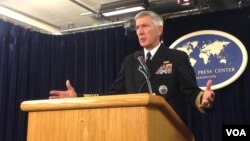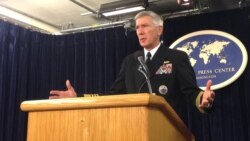“[The Asia-Pacific region] is the most militarized part of the world,” said Admiral Samuel J. Locklear, Commander, U.S. Pacific Command, at a recent security overview of the region given to international press in Washington, D.C.
“Seven of the world’s 10 largest-standing armies are in this part. The world’s largest and most sophisticated navies are here, and five of the world’s declared nuclear nations are [also] in this area.”
The U.S. Pacific Command, or PACOM, based in Hawaii, is the combatant command responsible for the Asia-Pacific region. Admiral Locklear stressed that the Asia-Pacific region, from a military perspective, is vast and complex. It covers about 50 percent of the globe with the world’s largest ocean, the Pacific; and contains more than 50 percent of the total 6.9 billion people in the world.
“The Asia Pacific is the engine that drives the global economy,” Admiral Locklear said. “There is $8 trillion of two-way trade in this region. 50 percent of the world’s cargo trade moves in this part of the world. And 70 percent of all the ship-borne energy assets move in this region every day.”
The challenges are many, from severe weather patterns and natural disasters that can impact vast populations, to transnational threats like terrorism, trafficking in drugs, wildlife, and human beings, and other illegal activities. There are also historic and emerging territorial disputes, and a growing competition for water, food, energy, and other resources.
“There is a lot going on in the Pacific area of responsibility,” Admiral Locklear said. “There is no single governance mechanism in this vast region to manage all the security relationships. There are many complex bilateral [and] growing multilateral relationships . . . We should . . . continue [to] ensure that . . . the leaders of these countries have the ability to continue to dialogue. So my goal is . . . to give peace and prosperity [the space] for those processes to work.”
“Seven of the world’s 10 largest-standing armies are in this part. The world’s largest and most sophisticated navies are here, and five of the world’s declared nuclear nations are [also] in this area.”
The U.S. Pacific Command, or PACOM, based in Hawaii, is the combatant command responsible for the Asia-Pacific region. Admiral Locklear stressed that the Asia-Pacific region, from a military perspective, is vast and complex. It covers about 50 percent of the globe with the world’s largest ocean, the Pacific; and contains more than 50 percent of the total 6.9 billion people in the world.
“The Asia Pacific is the engine that drives the global economy,” Admiral Locklear said. “There is $8 trillion of two-way trade in this region. 50 percent of the world’s cargo trade moves in this part of the world. And 70 percent of all the ship-borne energy assets move in this region every day.”
The challenges are many, from severe weather patterns and natural disasters that can impact vast populations, to transnational threats like terrorism, trafficking in drugs, wildlife, and human beings, and other illegal activities. There are also historic and emerging territorial disputes, and a growing competition for water, food, energy, and other resources.
“There is a lot going on in the Pacific area of responsibility,” Admiral Locklear said. “There is no single governance mechanism in this vast region to manage all the security relationships. There are many complex bilateral [and] growing multilateral relationships . . . We should . . . continue [to] ensure that . . . the leaders of these countries have the ability to continue to dialogue. So my goal is . . . to give peace and prosperity [the space] for those processes to work.”

















